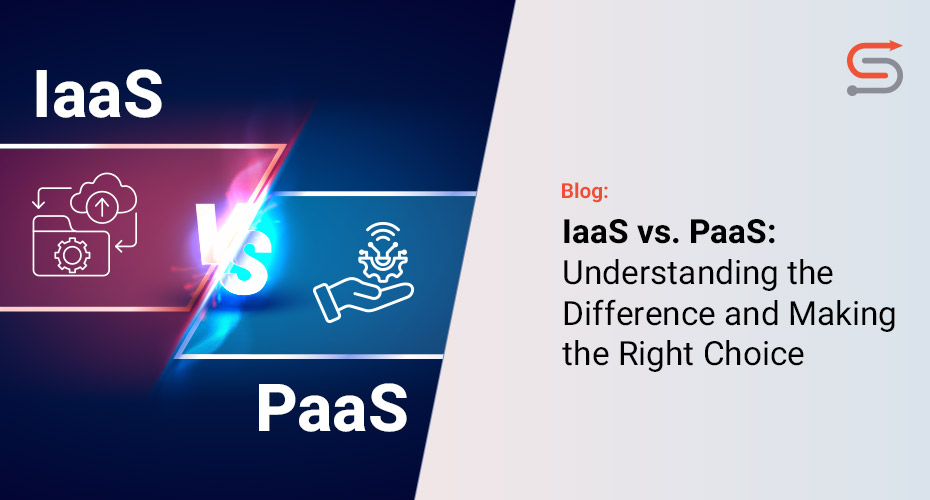July 31, 2023 - by Synoptek
As businesses become cloud-first, IaaS (Infrastructure as a Service) and PaaS (Platform as a Service) models have been experiencing immense popularity. Offering an array of application development, collaboration, and hosting capabilities, these models pave the way for high levels of flexibility, scalability, and security in the cloud.

But how does one decide which model to choose? How are IaaS and PaaS different? What factors should organizations keep in mind while making a choice?
While both models offer distinct advantages and are adopted by software development teams based on specific use cases and organizational requirements, read on to understand the many differences and make the right choice.
What Is IaaS?
IaaS, or Infrastructure as a Service, is a cloud computing model that delivers essential computing resources over the Internet. In an IaaS model, cloud service providers deliver essential computing infrastructure, including servers, storage, networking, and virtualization, as a service to organizations or end users.
With IaaS, businesses can access and consume these virtualized resources on demand, paying only for what they use. This eliminates investments in and maintenance of physical hardware or infrastructure. This allows companies to scale their IT infrastructure up or down as needed, based on fluctuating demands, without the need for significant upfront capital expenditures.
Examples of popular IaaS providers include Amazon Web Services (AWS), Microsoft Azure, Google Cloud Platform, IBM Cloud, and Oracle Cloud Infrastructure.
What Is PaaS?
PaaS, or Platform as a Service, is a cloud computing model that provides a complete and all-encompassing environment for developers to build, deploy, and manage applications. By delivering necessary development tools, runtime environments, databases, middleware, and other services, PaaS supports developers at every step of the application lifecycle.
Since it eliminates the complexities of managing the underlying infrastructure, developers can focus on writing code and creating applications. All provisioning, scaling, and maintenance tasks of the underlying infrastructure are taken care of by the cloud provider.
Examples of popular PaaS providers include Microsoft Azure, Google App Engine, AWS Elastic Beanstalk, IBM Cloud Foundry, and Red Hat.
How Are IaaS and PaaS Different?
IaaS serves as a foundational building block for various cloud-based services and applications. It enables businesses to focus on their core competencies while leaving the burden of infrastructure management to the service provider.
PaaS plays a crucial role in enabling businesses to leverage the full potential of cloud computing for their application development needs. It empowers developers to focus on creating innovative applications without worrying about day-to-day infrastructure management.
Despite offering similar capabilities, IaaS and PaaS differ in several aspects. Let’s look at the top differences:
| IaaS | PaaS | |
|---|---|---|
| Abstraction Level | IaaS offers a low level of abstraction, enabling users to have complete control over their infrastructure and software and tools associated with their business. | PaaS offers a slightly higher level of abstraction, enabling users to leverage infrastructure resources and development tools, runtime environments, databases, and middleware. |
| Application Development | With IaaS, developers manage the application’s runtime environment, databases, and middleware. Although they have greater flexibility and control over the software stack, they must handle administrative tasks related to the infrastructure. | PaaS simplifies application development by providing a complete development platform. Developers can focus solely on coding and building applications while the platform handles the underlying infrastructure and runtime environment. |
| Scalability | IaaS allows for easy scalability. However, developers need to implement auto-scaling mechanisms and manage the scaling process themselves. | PaaS platforms typically offer built-in auto-scaling features that automatically adjust resources based on application demand. This makes it easier for developers to scale applications without manual intervention. |
| Flexibility | IaaS provides greater flexibility in terms of configuring and customizing the infrastructure, making it suitable for applications with specific requirements and customizations. | PaaS offers less flexibility in terms of infrastructure customization, as it abstracts away much of the underlying complexity. While it streamlines development, it may not be the best fit for highly customized applications. |
| Maintenance | Organizations are responsible for managing the operating systems, application software, security updates, and other administrative tasks related to the infrastructure. | PaaS providers handle most of the infrastructure management and maintenance tasks. |
| Use Cases | IaaS is suitable for businesses requiring greater infrastructure control or having unique requirements that demand custom configurations. | PaaS is ideal for rapid application development. It is well-suited for startups, especially for projects that demand speed and scalability. |
| Benefits | IaaS offers the flexibility, scalability, and cost-effectiveness needed to meet infrastructure requirements without the burden of managing physical hardware. It allows them to focus on business growth, drive agility, and ensure seamless scalability. | PaaS allows developers to focus on building cutting-edge products without worrying about provisioning the underlying infrastructure. It enables them to be more productive, accelerate application development, and reduce time-to-market.Make the Right Choice |
The adoption of both IaaS and PaaS continues to grow as organizations seek to modernize their IT infrastructure, improve application development efficiency, and leverage the scalability and cost-effectiveness of cloud computing.
IaaS provides virtualized infrastructure resources, offering more control but requiring greater administrative involvement from the customer. On the other hand, PaaS abstracts away infrastructure complexities, providing a development platform that streamlines the development and deployment process.
The choice between IaaS and PaaS depends on the specific needs, development approach, and level of control desired by the business or team. It is also possible to adopt a hybrid approach and use a combination of both: IaaS for specific workloads or legacy applications that require customization and PaaS for rapid application development and deployment of new projects.